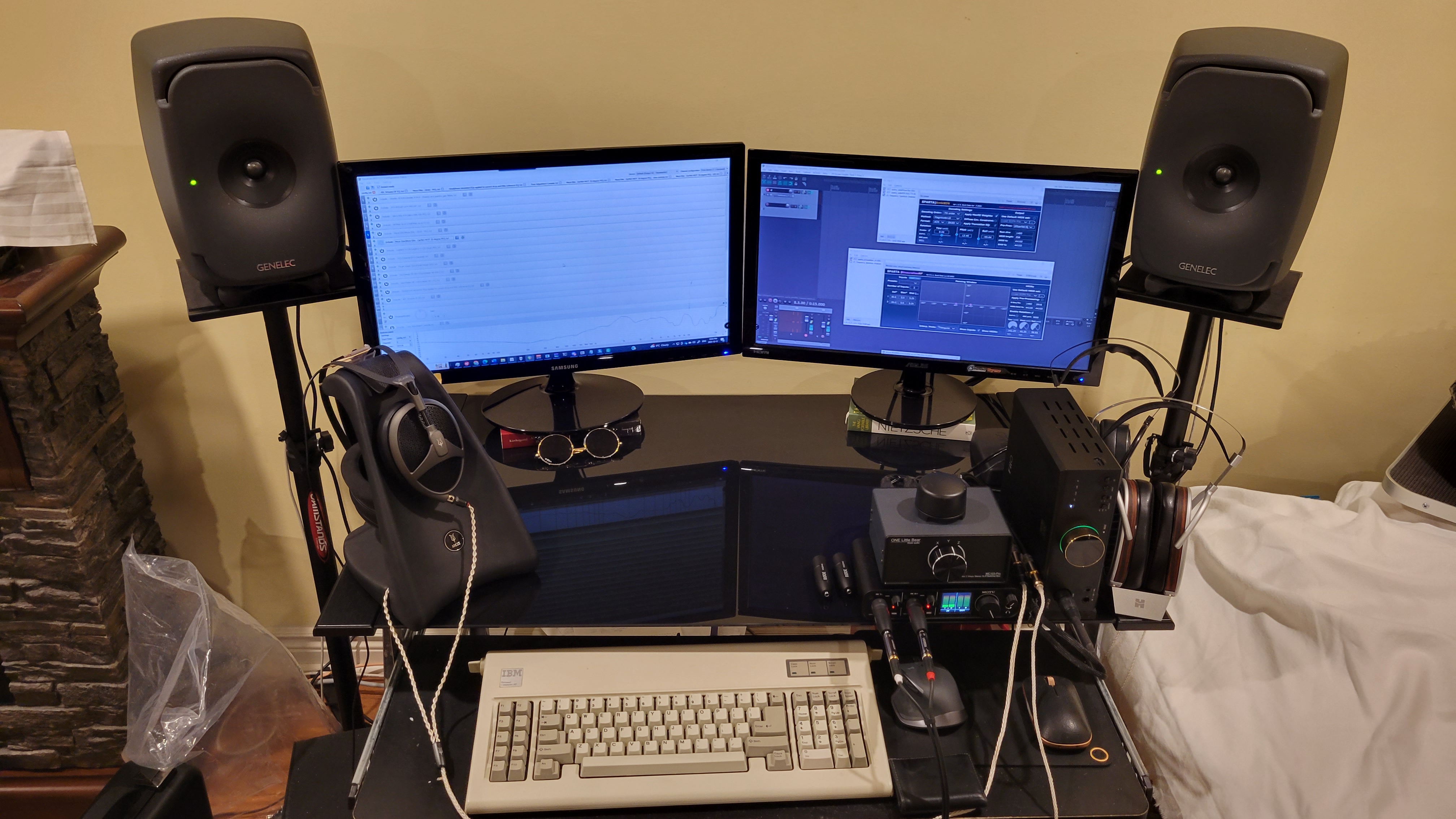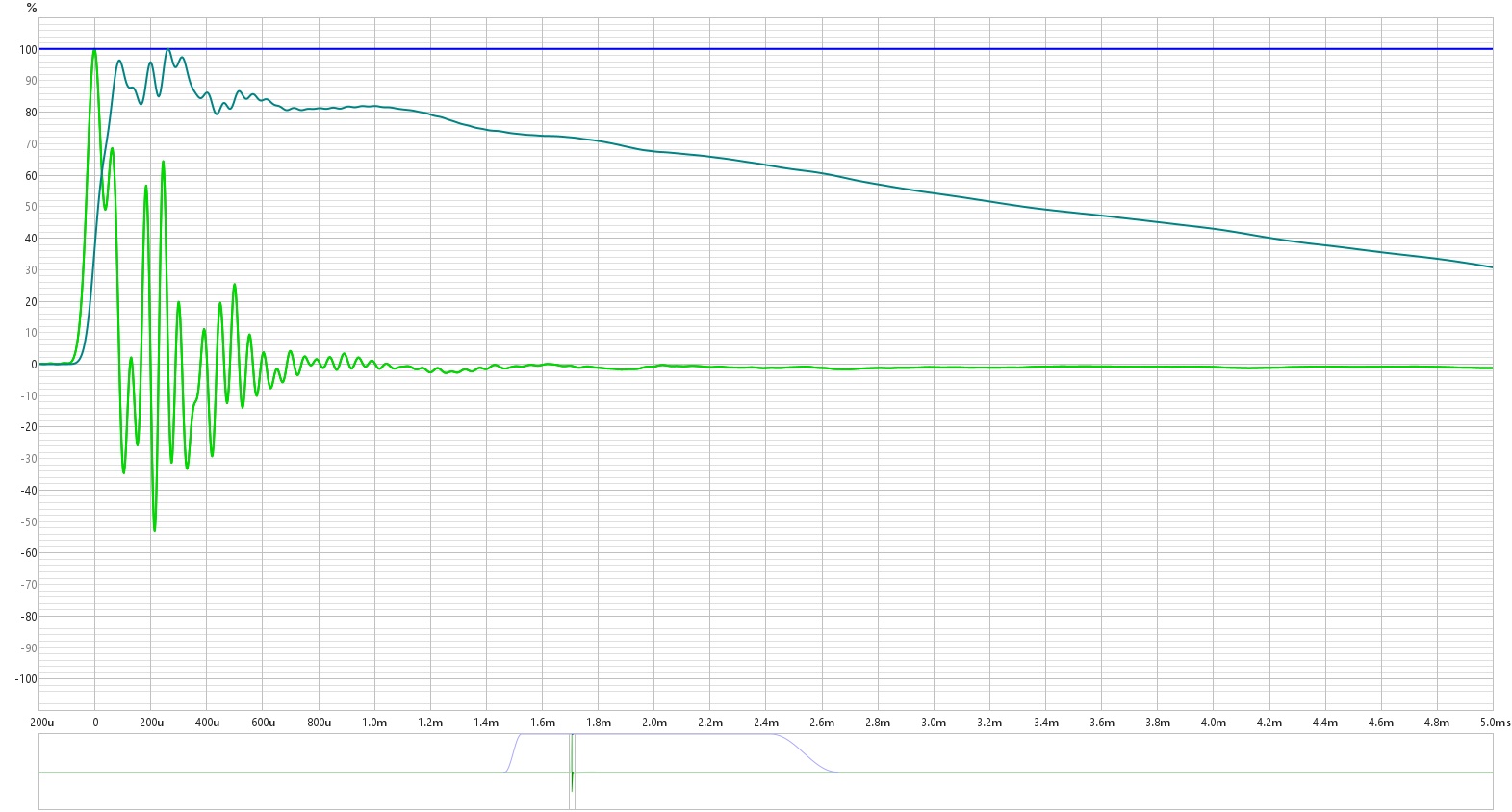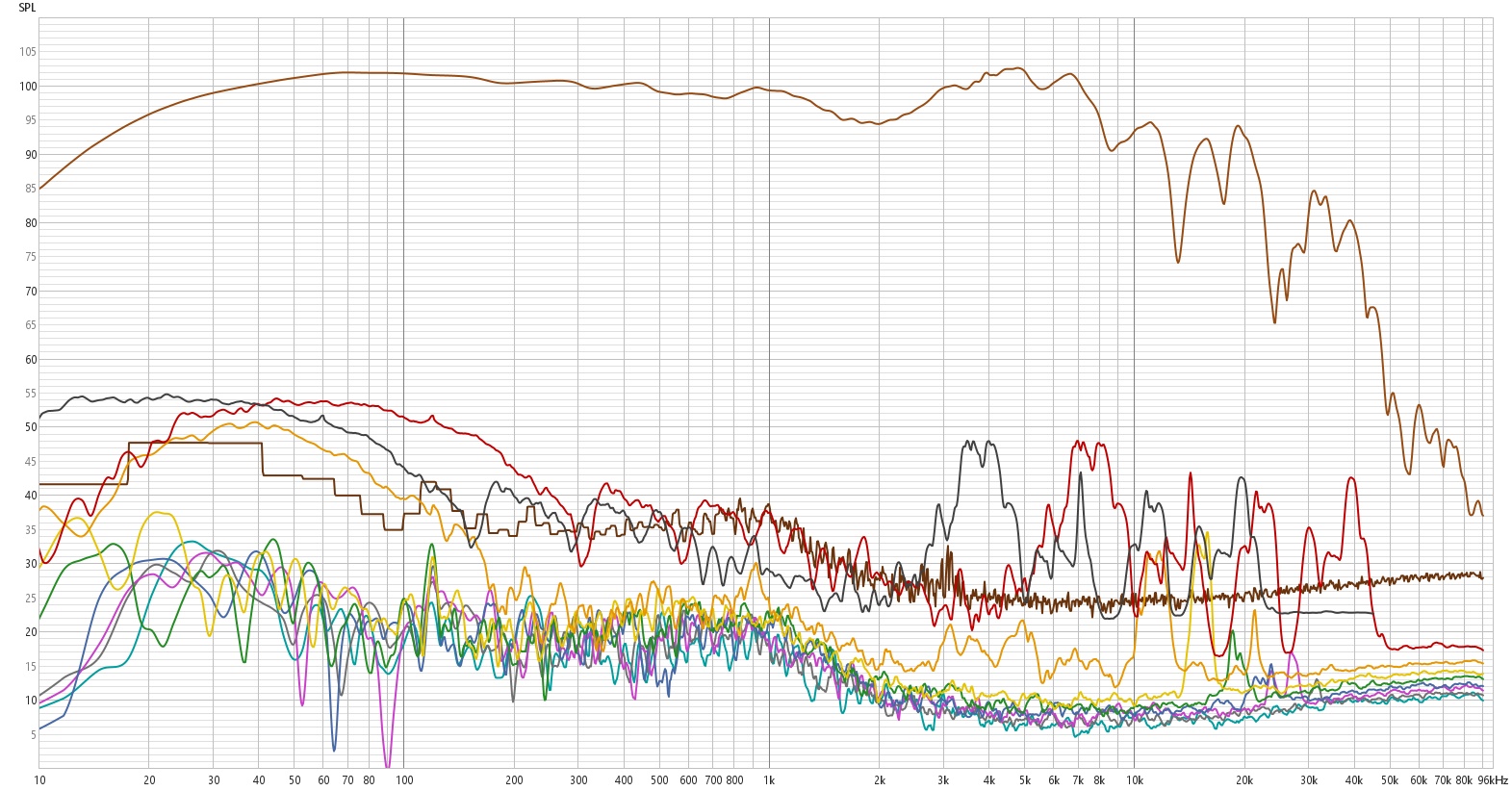And for ease of navigation, here are the preliminary measurements in a separate post (see
https://www.head-fi.org/threads/in-...c-headphones-frs-are-indeed-identical.970202/ and
https://www.head-fi.org/threads/mez...eadphone-official-thread.959445/post-17743502 (post #5,152) for measurement methodology and other measurements to compare against including the Sennheiser HE-1):
2024-04-04 - Disclaimer: All of my REW distortion measurements posted between November 2023 (the acquisition of my MOTU M2 and the start of my "100 dB SPL" calibration methodology) and April 2024 are per my latest SPL calibration methodology and due to the cheap 11-month-old HT-80A SPL meter having actually been quite off at least after all that time are around 4 dB too high, so "100 dB SPL" would be closer to 96 dB SPL if my new SPL calibrator is to be trusted.
Magnitude and phase response:
Figure 1: HiFiMan HE1000se magnitude (red trace) and phase (green trace) response. No major peaks, which is good, though 6.6 kHz sticks out a bit at least due to the preceding dip. This sine sweep was the very first signal I played through this headphone, partly to debunk the existence of major HiFiMan "driver burn-in" that is not pad-related or psychological.

I had used the headphones.com calculator to estimate how loud the HE1000se would play for the same amp volume setting if I measured 100 dB SPL for the Arya Stealth. As such, compared to the Arya Stealth measurement, this one has a -2 dB digital preamp applied for volume-matching. From my measurements, it seems like the that digital preamp wasn't actually needed, their actually already playing at very similar levels for the same amp volume. The HE1000se has a rounded "HiFiMan dip", and less driver resonance ripples in the midrange. Compare this smoothness to the Sennheiser HE-1 measurement shown in
https://www.head-fi.org/threads/mez...eadphone-official-thread.959445/post-17743502 (post #5,152) under the "2023-10-27 addendum".
Figure 2: HiFiMan Arya Stealth magnitude (green trace) and phase (purple trace) response. Prominence at 4.2 kHz along with a phase anomaly there, not as bad on the right channel. Both headphones for my ears have a shallow dip at 8.6 kHz where it can be deeper in some other headphones. Here, the HE1000se for my ears has a shallower dip at 13 kHz where the Arya Stealth has a sharp notch while at 17 kHz, the cases are reversed. The HE1000se seems to have less sub-bass, which is unfortunate, whether or not that will improve with the pads breaking in. The top octave levels are also a bit higher on the Arya Stealth.

Figure 3: Meze Elite hybrid pads with V3 PEQ magnitude (green trace) and phase (blue trace) response. This is my original preferred response as derived from EQing the Meze Elite toward the Harman target using the headphones.com GRAS measurements, EQing down treble peaks by ear toward equal loudness using sine sweeps and pink noise, and smoothing the response after acquiring in-ear microphones to produce measurements like the above; the un-smoothed EQed-by-ear response was wavy, but still had this general flat trend. The minimum-phase EQ corrected the phase response to appear as flat as shown. The 7.7 kHz, 13.7 kHz, and 17.7 kHz nulls are perhaps thanks to the driver damping much shallower than on most headphones, making it very easy to EQ them to be flat (measurably without much of a distortion penalty) to create a blank slate for EQing in the direction-variant nulls in binaural head-tracking.
Harmonic Distortion:
For the below distortion plots, the magnitude response is shown at the top in brown as the playback level the harmonic distortion components exist relative to. The dark brown trace is the noise floor. The black trace is the total harmonic distortion (THD) for the given frequency. The red trace is the second-order harmonic distortion plotted at its actual harmonic frequency rather than with its fundamental frequency. The orange trace is the third-order harmonic distortion in similar fashion. The rest are for higher-order harmonics. Even-order harmonics are potentially euphonic when audible, while the odd-order harmonics are more audible and more likely to be unpleasant when audible.
Figure 4: HiFiMan HE1000se distortion plot. So we already saw some slight tonal improvements in the frequency response within the upper midrange and treble, whereby we also do at least have upwards of 5 dB improved distortion performance compared to the Arya Stealth.
Figure 5: HiFiMan Arya Stealth distortion plot. Interesting dip in THD from around 100 Hz to 160 Hz.
Figure 6: Meze Elite hybrid pads with V3 PEQ distortion plot. As can be seen, the Meze Elite when EQed to my fine-tuned Harman-like target still reigns superior for bass distortion, though the HE1000se comes to compete a bit better in the midrange and treble except at the 4 kHz resonance. I do find it interesting that the HE1000se still has this 4 kHz distortion peak despite there being no corresponding peak or dip in the magnitude response.
Cumulative Spectral Decay (CSD):
When listening to transients, particularly as isolated by the sound file in
http://pcfarina.eng.unipr.it/Acustica-samples/Dirac.wav, at least when playing that single-sample impulse loud, I have found the raised decay components to be audible, whereby ideally for a high-end headphone, this should be clean without sacrificing transient sharpness. As for the below charts, we want the top of the frontmost blue region to be as low and flat as possible.
Figure 7: HiFiMan HE1000se CSD. The CSD is unfortunately not much better than on the Arya Stealth, its seeming to be a bit worse around 3.3 kHz.
Figure 8: HiFiMan Arya Stealth CSD.
Figure 9: Meze Elite hybrid pads with V3 PEQ CSD. After EQing the midrange and treble to similar levels, the decay levels become more comparable with both HiFiMans, whereby EQing the region after 4.4 kHz down may help those HiFiMans to exhibit a more comparable CSD. Now, my Jabra Elite 85h and Audio-Technica ATH-M50xBT actually have the cleanest midrange and treble CSDs out of my headphones, but seemingly measurably at the expense of duller step responses and hence subjective transient sharpness due to all the damping within those closed-back designs. Also, there is a chance that these HiFiMans do have superior bass decay speed when EQed to the same bass quantity, but again, the Meze Elite's bass distortion is exceptional by comparison.
Group Delay:
Figure 10: HiFiMan HE1000se group delay. These HiFiMans have had the smoothest bass group delays out of the headphones I've measured, whether or not that contributes to their incisive character.
Figure 11: HiFiMan Arya Stealth group delay. Very similar, but with more ripplers from slightly steeper driver modes.
Figure 12: Meze Elite hybrid pads with V3 PEQ group delay. By default with the rear volume padding foam, the group delay in the upper midrange and treble was slightly cleaner, but it became indeed cleaner yet like so when holding a piece of acoustic foam in front of the driver grille to absorb radiated sound, whereby it may have indeed been external reflections that were contributing to this noise. This also improved the CSD measurement and should likely improve the same for the HiFiMans. Anyways, even after EQing the Meze Elite to measure as flat as I had made it in both magnitude and phase, the bass group delay still wasn't as smooth as on the HiFiMans. The rest of the group delay is otherwise better behaved, even around the 360 Hz driver mode which I had at least somewhat EQed flat.
Impulse and Step Response:
I had found that the step response as calculated from the integral of the impulse response (itself calculated from the Fourier transform of the sine sweep) seems like a decent objective measurement of "speed", "impact", and "transient sharpness", whereby one is looking for a fast rise with a sharp edge, some overshoot potentially contributing to a greater sense of incisiveness. For subjective transient sharpness, you can listen to
http://pcfarina.eng.unipr.it/Acustica-samples/Dirac.wav to better isolate the sound of the sharpest transient possible. In the below, the step response is shown in teal while the other trace is the impulse response that step response was integrated from. See
https://www.head-fi.org/threads/stax-sr-x9000.959852/post-17850191 (post #2,738) for more comparisons, particularly with my "duller" lower-end dynamic headphones.
Figure 13: HiFiMan HE1000se impulse and step response. This headphone is indeed quite incisive at the start, having a large undershoot in the impulse response that creates a dip in the step response that may or may not contributed to a sense of sharpness, but maybe also a sense of transient dirtiness.
Figure 14: HiFiMan Arya Stealth impulse and step response. The first peak on the HE1000se's step response may be slightly higher. The HE1000se's impulse response noticeably (in measurement) decays around 200 us faster than the Arya Stealth's. The Arya Stealth with its 4.3 kHz resonance incurs more ripple at that frequency within the impulse and step response. Otherwise, the shallower slope toward zero is consistent with this headphone's having better sub-bass extension than the HE1000se at least with the latter's pads having not been broken in.
Figure 15: Meze Elite hybrid pads with V3 PEQ impulse and step response. With EQ, the Meze Elite can technically come to be just as fast in impulse response decay and step response sharpness, mind cleanly so.
Subjective Impressions:
Well, the subjective diminishing returns are about as much as with these objective measurements. With a reasonable volume-match, I am personally barely hearing any notable differences in "soundstage", "bigness", "openness", "detail", or imaging, or if ever I think I heard a difference, it is largely gone after going back to the previous headphone. As for imaging, if a trumpet in Mahler 5 sounds initially a bit forward and to the right, then up in front of the right of my forehead with one HiFiMan, it is also so with the other. Far-panned sounds are imaged right from the drivers for me, nothing extending far out without special effects having first been mixed into the recording. Rodrigo y Gabriela tracks with all their transients, imaging, and details, sound very similar on both. And I highly doubt that "burn-in" would fix that, especially when this default headphone imaging without crossfeed now sounds hideously distorted compared to the proper speaker imaging I can hear through my Genelec 8341As, and the improved clarity on top of that when simulating such with binaural head-tracking.
Anyways, this result is certainly more palatable after having paid only $2k as opposed to $3.5k for these beautiful cans. I already knew that when two headphones come to have a very similar frequency response, when volume matched, especially when the driver and earpad size are virtually the same, there will be barely any differences for me to notice. As such, the only thing for me to enjoy is knowledge of superior objective performance and the confidence in the sound being delivered with lower distortion or cleaner and un-dulled transients.
Otherwise, we shall see tomorrow how the Dekoni pads measure and whether they can regain some sub-bass and maybe even render the distortion and CSD more competitive. At least today's results technically showed the HE1000se coming close enough to the Meze Elite's performance while fulfilling the purpose of achieving that binaural head-tracking presentation
with greater comfort and openness. The only thing that was stopping me from EQing the Arya Stealth to the same free-field EQ for neutral speakers in an anechoic chamber was my awareness of its inferior distortion performance.













































































































